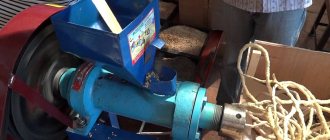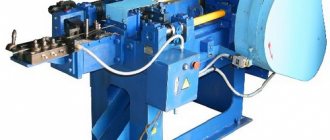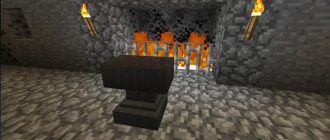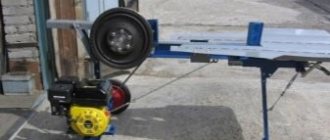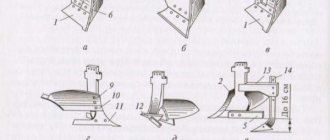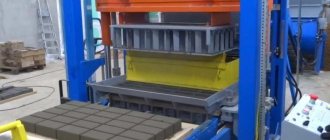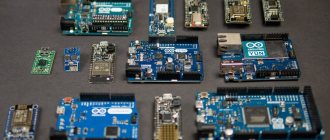- power – ranges from 3 to 20 kW, which is decisive for the size of the finished product;
the ability to produce nails of different lengths - from 12 to 32 mm;
A special module will also be needed in this case, if the finished products are coated with an additional layer - brass, copper, zinc. With fairly large production scales, it turns out to be more profitable to galvanize products on site than to use ready-made wire.
The cost of a machine for producing nails depends on all of the above reasons, as well as on the country of origin. Today, products made in Taiwan are considered good. The range of prices is very wide - from 350 thousand rubles. up to 900 thousand rubles Equipment that has already been used can be purchased at a much lower cost - from 120 thousand rubles. You can also try making a machine for making nails with your own hands.
Now you understand how much a machine for producing nails costs, then you will find a business plan model for production, which, according to reviews, is more applicable.
This video will tell you what a nail making machine is:
Description of the nail structure
Modern equipment for the production of nails is a complex production complex, which is designed to perform several types of operations. Because of this, making it yourself will be very problematic.
The main manufacturing material is wire made of steel, copper or brass. It is supplied in coils, so before production begins it is necessary to carry out its processing - unwinding and straightening. Then you can start producing finished products.
Stages of nail production using a special machine.
- Installation of wire into the gripping mechanism of the equipment.
- Pulling the workpiece, as a result of which it is leveled.
- Forming the nail head. Screw-cutting heads are used to fix the workpiece. The wire end is deformed using an impact mechanism. As a result of this, flattening and formation of the cap are performed.
- The workpiece is pulled to a specified length. A pair of cutters cut on both sides, thereby forming the sharp end of the nail.
- Finished product
This is a general description of the production process using a nailing machine. Despite the slight difference in the layout of equipment models, the production process technology remains unchanged.
In order to optimize the cost of purchasing equipment, you can make an unwinding device yourself. It is a conical metal structure mounted on a vertical support post.
The process has begun...
Launch Corel, create a layout:
- outline of boards
- markings for drilling for nails (I make the diameter of the drillings 2.4 mm so that the nail fits in with tension and fits securely)
- markings for the lid
- markings for drilling for self-tapping screws
We create a CNC control program. We securely secure the workpiece into the machine and start the process of drilling and cutting the boards. Drilling boards on one side takes approximately 1 hour, another 40 minutes for drilling with a V-shaped countersunk cutter.
After the holes are ready, we can cut the boards to our dimensions, but while we have a V-shaped cutter installed, we will run it along the contour of the cut and chamfer it. Next I change the cutter. I install a single-thread cutter with chip removal downwards, diameter 3 mm, and cut our boards along the contour.
Milling on one side is complete. Now you need to turn the boards over and make pockets for the nail heads so that they do not interfere with the tight fit of the bottom cover. Well, at the same time we’ll make drillings for the cover fastening screws.
Next you need to make the lids, the process is similar to the previous one. We put a sheet of plywood or plastic in the machine, mill out places for the anti-slip feet, and make holes for the screws. Next, cut the lids along the contour. The size of the cover and base of the boards must be identical.
Milling work takes about 3 hours. When the blanks are ready, you need to sand them and coat them with varnish and/or stain. After coating, let our boards dry (leave overnight).
When the blanks have dried, we can finally begin driving in the sorted nails. We hammer 1100 nails, it takes about 2 hours :). Screw on the lid, glue the cork legs and voila, our products are ready.
List of main technical characteristics
The next step is to determine the required technical and operational qualities of the machine. The defining indicator of nailing equipment is its productivity, i.e. speed of production of finished products by the machine. But in addition to this, a number of other factors should be taken into account.
The drive of all moving mechanisms is often carried out through cam units. They are connected to the electric motor. The speed of operations, as well as the maximum diameter of the steel workpiece, depends on it. Setting up the equipment is carried out by adjusting the wire feed units, setting the force of the impact mechanism to form the nail head. In this way, you can set the operating frequency of all machine mechanisms.
Main technical characteristics of equipment for making nails:
- maximum and minimum diameter of the rod;
- limits for changing the length of the workpiece;
- performance;
- weight and dimensions of equipment;
- power consumption of the electric motor.
The diameter of the finished nail head depends on the cross-section of the wire. The impact mechanism has a standard size. During the production process, you can only change the amount of force exerted on the workpiece.
The advantage of modern nail production machines is the almost complete automation of their operation. It is important to correctly configure the primary parameters and timely feed the wire into the gripping unit of the machine.
Finding premises for organizing activities
To organize activities, you will need a premises with a total area of at least 150-200 sq.m. On its territory there will be equipment for production, a warehouse, offices for an accountant, a technologist, a manager, a canteen and a locker room. It will be difficult to buy it, since an object with such a square footage will cost about 10-15 million rubles. It’s easier to rent production space. An object somewhere on the outskirts of a populated area would be suitable. It is desirable to have an asphalted area and equipped entrances. This will facilitate the delivery of raw materials and loading of finished products to consumers. The cost of renting a premises of 200 sq.m. it will cost about 100,000 thousand rubles per month. In small towns this figure is several times lower.
Here you need to add one-time work on organizing a workspace for personal needs - 200 thousand rubles.
Optional equipment
In addition to the above, it is recommended to purchase several additional units for the production installation to optimize the production process. They are designed for subsequent processing of nails and their packaging.
The wire used has a protective layer of lubricant that prevents it from rusting during storage. However, this gives the finished product a non-marketable appearance. Therefore, for final processing of nails, it is recommended to purchase or make your own industrial rotating drum.
It is a container installed on a supporting structure. On one side the drive from an electric motor is connected. The drum is filled with a small amount of caustic soda and ready-made nails. During the rotation process, the surface of the products is cleaned. After this treatment, the nails are completely ready for packaging.
Additionally, you can buy a filling machine. With its help, even at the production stage, you can make packaging of finished products for further storage or sale. You must first purchase containers for packaging the finished product.
For a detailed understanding of the operating principle of the nail production machine, it is recommended to watch the video:
Read also: Glass hardness according to Rockwell table
Possible board layout options
I know different options for marking boards for driving nails (pattern of nails). Nails can be arranged in the shape of a rhombus (see figure ↑), square or hexagon (aka “flower of life”, also known as “hexagon”). The most interesting is the “flower of life” marking, the nails are located at the intersection points of 7 circles (seven circles, seven intersection points, seven nails)
The difference between them is obvious, but it’s difficult to say anything about how the drawing affects the practice of standing, because currently 100% of my boards are marked in a diamond shape. When I conduct an experiment with a different pattern, I will certainly report the results.
For convenience, I saved the nail marking schemes in .PDF and .SVG format (for those who need a vector)
Nailers
Our joint stock company offers various models of nailing machines, which allows you to choose a machine model that produces nails in the range from 20 to 80 mm (model AG4115), from 32 to 180 mm (model AG4116), from 20 to 150 mm (model AG4117). The automatic machine for producing nails is a full production cycle; the operator only needs to set the mode, load the wire and sharpen the knives as he works.
How the machine works
- wire wound into large spools is fed into the machine;
- the machine cuts the wire to a given length;
- the nail head is formed.
This completes the operation of the machine, but the nails must be packed. For this, there are separate machines, when purchased, in addition to nailing equipment, you can get a ready-made production line.
Customer assistance
We understand that purchasing equipment is only the first stage in starting production. But he is the most important. In addition, we offer services:
- delivery of a nailing machine;
- personnel training;
- for a stable supply of spare parts and consumables for the machine;
- You can separately purchase a machine for sharpening knives for nailing devices.
How to order?
In order to select the necessary equipment, get a free consultation, find out the full cost and choose a transport company, you need to contact the plant employees at the phone number listed on the website, order a call back or submit a request by email. The company manager will clarify all the details and issue an invoice. Payment is made in cash and by bank transfer. The equipment is supplied complete with all necessary documentation. It is worth paying special attention to the guarantee provided by the manufacturer for 18 months. As well as for additional services that are often required during the initial stages of installation and startup.
High-quality machines for the production of various nails for wood work are needed in various industries. provides a full range of services, from sales of the equipment itself to on-site consultation on the use of a nailing machine.
Manufacturing nails can be a very profitable business, but only if the hardware equipment works flawlessly for a long time.
First of all, you should purchase and install a nail production machine. Such equipment is produced both in our country and abroad, so before making a final decision on purchase. It is necessary to find out all the necessary characteristics of such a product.
Sadhu board material
You will be surprised how much you need to do a seemingly simple job. Hammer nails into the board and that’s it, that’s what I thought when I first started making Sadhu :), but first things first…
You can use plywood, solid wood, furniture panels made from various types of wood and even chipboard. However, I chose good quality birch plywood, which in my opinion is the most suitable and affordable material for our task. We use 18 mm plywood as the base of the boards; we will also need thin plywood (6 mm) or a sheet of plastic to make the bottom cover and cover the nail heads.
Types of nail production machines
The units differ in power and performance. The power of such equipment usually ranges from 3 to 20 kW.
The higher the power of the machine, the greater the number of hardware will be produced in 1 minute. The ability to work with large-diameter wire will depend on the power of the equipment.
The maximum thickness of nails produced by such automatic installations is 9 mm. At the same time, the minimum diameter of wire that can be used for the production of hardware usually does not exceed 1.2 mm.
Read also: Vacuum cleaner power regulator diagram
Before purchasing equipment, it is also necessary to determine the maximum and minimum possible size of the hardware produced. The length range of manufactured products can be from 12 to 320 mm.
Board size for comfortable standing
How do you know what size the board should be? Take a sheet of A4 paper, place a foot and trace it with a pencil. Next, measure the maximum length and width of the foot with a ruler. I got a length of 27-28 cm and a width of 9-10 cm. Let’s add 2 cm to each side so that we don’t have to aim when placing the foot, and we get a nail area of 30*12 cm. And we’ll also add 1.5 cm and we will already get the size of the base of one board 33*15 cm.
For clarity,
Working principle of wire nailing machine
The nail making machine works as follows:
- The device is supplied with wire of the required diameter.
- Using special knives, the wire is cut into pieces of the required length.
- The workpiece is securely clamped and a cap is formed.
- The nail is sharpened from the opposite side.
After complete completion of this process, the finished product is released. Depending on the size of the hardware and the performance of the machine, complete cycles in 1 minute can be from 100 to 600.
Equipment for producing nails allows you to produce up to 3 tons of finished products in 1 work shift. With the right approach to organizing such a business, you can pay for the purchased equipment within a few months.
Sales of products
Every construction site, production facility and every residential building requires the presence of nails in varying quantities. They are used for a wide variety of activities - from assembling furniture to assembling frames for pouring foundations. At first glance, the need for nails is simply enormous, and the owner of the enterprise will definitely not be left without orders. But, you need to understand that many wholesale buyers prefer to cooperate with large suppliers, and also take into account competitors. The domestic market offers nails not only from local manufacturers, but also from foreign companies. To get a competitive enterprise, you will need to thoroughly promote it with the help of advertising, produce high-quality products and sell them at low prices. Only compliance with the three specified factors guarantees the success of future entrepreneurial activity.
Of course, there is no point in standing on the market and selling nails produced at your own enterprise. Such an implementation is unlikely to recoup investments in production even after many years. Sales must be large-scale. Nails should be supplied to large construction hypermarkets and small stores. It would also be useful to sell it through online stores. You can negotiate the supply of your own products to retail outlets yourself or hire a sales manager. He will be fully engaged in this activity. With a successful combination of circumstances, in a month it will be possible to establish serious sales.
Popular models of wire nailing machines
It is better to purchase time-tested equipment that has already been tested in real operating conditions. The only exception to this rule is the possibility of purchasing a device from a trusted manufacturer who has released a new machine model with improved performance.
Currently, the following models of units are used for the production of nails:
1. AB4118 is a single-impact wire-nail machine that produces hardware with a diameter of 2.5 to 6.3 mm.
The length of nails produced by the machine can range from 32 to 200 mm. The equipment allows you to produce hardware not only from round wire.
With AB4118 you can produce square and screw profile nails. The mass of the device is 4720 kg, the engine power is 11 kW. Cost after repair (used) RUB 280,000.
2. K09.117.02 - high-performance device for making nails.
The length of manufactured products ranges from 13 to 150 mm. The maximum wire diameter is 5 mm. Power - 5.5 kW. Weight - 2900 kg. Price (used) 230,000 rub.
3. K09.117.01 - wire-nail machine for hardware with a length of 13 to 120 mm.
Nail diameter from 2.0 - 4.2 mm. The device has high performance with a total power of 5.5 kW. Power is supplied from a three-phase current network with a voltage of 380 V. You can buy a used unit for 180,000 rubles.
4. AG4116 - single-impact model for releasing nails with a length of 13 to 250 mm. Cost (new) 950,000 rubles and used 180,000 rubles.
For the manufacture of hardware, nailing wire with a cross-section of 2.0 - 4.2 mm is used. Productivity remains at least 350 pcs/min.
5. ASG 4.02 - allows you to produce hardware up to 120 mm long. Engine power - 5.5 kW.
With this power, it is possible to achieve a nail productivity of up to 525 pcs/min. The weight of the device is 2650 kg. Average price - 420,000 rubles.
6. Z94-2C - model of wire-nail device for hardware with a diameter of 1.2 - 2.8 mm. Cost from 280,000 rub.
The productivity of the device with a rated power of 2.2 kW is at least 350 pcs/min. The length of manufactured products is from 16 to 50 mm.
7. TNA 40/120 SE - Czech machine for making nails, characterized by high productivity and product quality.
Read also: Which automatic machine to put into the house
It is possible to obtain products up to 120 mm long with a wire diameter of 40 mm.
8. Z4-x - a Chinese unit with a power of 3 kW produces hardware up to 100 mm long, in quantities up to 300 pcs/min. Weight 1430 kg.
9. E127LYHIA - wire nailing machine made in China. The equipment allows us to produce high-quality products.
The machine is also characterized by low noise during operation. The length of manufactured hardware ranges from 40 to 110 mm. Engine power - 4 kW. Check the price with the seller.
All of the listed units are ideal for organizing your own business, and the choice of a specific model depends on the required performance and the size of the hardware.
How to choose the right machine
The choice of wire nailing machine depends on many factors, but first of all you should pay attention to the following characteristics:
- Wire for releasing nails can be used with a diameter that does not exceed the maximum value specified in the data sheet. The diameter also depends on the length of the hardware. As a rule, the longer the product required, the thicker the wire should be.
- Length of nails - all machine models have a limitation on the size of the hardware. Most units can cope with the need to produce products from 2.0 to 100 mm, but if you need an automatic machine for smaller or larger nails, you should carefully study the technical characteristics of the device before purchasing it.
- Productivity - the higher this indicator, the higher the profit from the steel products business. High-performance models designed for the production of large-sized nails have high engine power. Before opening such a production, you should make sure that there will be no problems with connecting to the three-phase electrical network.
- Manufacturing of non-standard products - as a rule, round steel wire is used, but in some models of wire-nail machines, square and screw-cut raw materials can be used. If you need to produce just such a product, you should take care in advance to purchase a machine with advanced capabilities.
- The ability to adjust the size of the head - in the case when it is necessary to produce non-standard products with a wide head, this function will be especially necessary.
- Cost - you can purchase equipment for releasing nails at a price of 120 thousand rubles. up to 1 million rubles The price of a machine directly depends on its performance and the presence of additional functions, so if there are financial restrictions, you can start a business by purchasing a small device, with a gradual expansion of production by directing part of the profit to these purposes.
- Size and Weight – A nail making machine can weigh over 5 tons. With such a mass, the dimensions of the device will also be significant. In order to place the machine in the intended room, it is necessary to calculate its dimensions in advance.
The selection criteria listed are the main ones, therefore, before purchasing a machine, you should find out all its characteristics and correlate them with the requirements that will be placed on the equipment at the enterprise.
nail shop
Blacksmith's nail shop. Photo ForgingPRO
For the production of forged nails, a nailing device is used. With its help, a thickened nail head is made. Formation occurs in the cavity of the nail body, which acts as a stamping matrix or by riveting on the surface. Further shaping is carried out using an overlay matrix (“top”).
Differences between a manual nailer and a nail plate
The nailer is manufactured as a separate mold on the handle (manual nailer) or as a steel plate with many form-building cavities of different sizes (nail plate).
The nail plate is used in blacksmith shops, where the production of forged nails of various sizes is part of the specialization of this production.
Forged nails, for example, can be used in the manufacture of furniture with elements of antique decor.
Nail plates are installed on an anvil , ensuring the possibility of overturning when knocking out finished nails.
Manual blacksmith nailer. Photo ForgingPRO
Manual nailers are used to fulfill one-time orders; they can be placed anywhere in the blacksmith’s workshop, including a workbench drawer.
How to make a nail forge for a forge
To carry out work on the production of forged nails, rivets and blanks for bolts, the equipment can be done by hand.
Manual
There are many manufacturing options depending on local conditions. Here we will describe one of the possible options.
You will need an anvil to make your own blacksmith nail. Photos Stankocentr
To perform the work you will need the following materials, equipment and accessories :
- metal rod with a diameter of 30-40 mm;
- low carbon steel rod with a diameter of 6 mm. for handle;
- spring steel rod (old car suspension spring);
- hand blacksmith fork;
- stationary forging fork;
- blacksmith's pliers;
- cup-shaped backing tool;
- blacksmith chisel;
- hand forging hammers;
- anvil;
- universal locksmith tool;
- forge forge for heating workpieces;
- air hammer;
- universal grinder (grinder);
- welding machine.
The procedure for performing actions in the manufacture of a manual nailer.
- Using a grinder, the required length of spring steel .
- Using stationary and manual forks, forging tongs and a hammer, the heated wire is aligned . This will be a blank for making firmware.
- We use hot forging technology to produce firmware . The firmware is a tetrahedron in the form of a pyramid. We cut off the finished firmware from the rod using a forge chisel.
- the mold for making nails using hot forging using a pneumatic hammer . A cup-shaped backing tool produces a groove on the side surface of the mold cylinder.
Grinder Bosch GWS 850 CE. Photo 220Volt
- The grinder removes irregularities inside the groove , obtained during shaping using the hot forging method. Cleaning is carried out using metalwork tools. A circle bent from wire with a diameter of 6 mm should fit into the groove.
- The hole for the firmware is marked and punched . Using a drill whose diameter is equal to the maximum size of the side of the firmware square, a hole is made along the markings.
- In a heated mold, using impact piercing, a tetrahedral cavity is cut . Cutting is done from the back side of the working part of the mold.
- The handle consists of two parts : a round part that fits tightly into the groove on the form and the holder itself, bent from the same rod with a diameter of 6 mm. Both parts are connected to each other by a weld.
Brief description of the work: a forged rod for riveting the head is inserted into the mold until it stops. An allowance for riveting the head is marked and the required size is cut off on a forging chisel. After the technological operation, the workpiece is freely knocked out with blows from the reverse side (the tetrahedral hole is larger here).
Stove
To make a nail plate, the most important point will be to find the necessary blank . must be hard after hardening . Mark the slab according to the number of standard sizes produced. To shape each of the holes, you can use the technology described for a manual nailer.
Tools for working with nails
From the description of the manufacturing technology of the nail house, as well as the forged nails themselves, it is clear that the work is impossible without the use of other blacksmith tools: forge, anvil, forks, hammers, sledgehammers, tongs and various auxiliary devices.
Hand forged fork. Photo ForgingPRO
- A forge is a device where heating occurs to a temperature that ensures deformation of the workpiece during hot forging operations.
- The anvil is the main working tool-device for performing forging operations.
- Hammers are designed for manual impact work directly involved in the shaping of small workpieces.
- A sledgehammer, having a heavy head, is used to deliver blows of much greater force than conventional hammers.
- Hand forks and forks in blacksmithing are mandatory participants in all bending operations.
- Pincers are used to hold heated workpieces during hot forging operations. The working part of the pliers is made in accordance with the shape of the workpieces.
- Chisels are used to perform parting operations.
All blacksmithing accessories are made by hand, provided the appropriate material is available.
The pliers are made from rolled steel that is not hardened. Constant heating and cooling should not affect the structure of the material.
A fork can be welded from pieces of corner and scrap metal.
For the heads of hammers and sledgehammers, use steel grades 40X, 45 for forging the working part.
An anvil at home is made from a piece of rail or channel.
The forge includes many DIY options. It can be simple, made of brickwork, or quite complex, consisting of a metal structure with the organization of blowing to obtain a higher heating temperature.
Where can I buy
On our website, a separate section contains companies that offer to buy nail shops. Here you can familiarize yourself with the characteristics of the product and estimate the purchase price. The site also offers for consideration companies that produce and sell other types of forging tools necessary for the production of forged products: chisels, hammers, pliers.
Sections: Tool, Tool
What you will need
To manufacture products you will need premises, raw materials and a production base. All 3 components are quite accessible, since the production process does not require any special conditions - pressure, humidity, or complex technological operations.
Raw materials
The vast majority of nails are made from low-carbon steel grade St. 1, Art. 2, Art. 3, Art. 5, Art. 10, Art. 15. The material is manufactured at any metal rolling plant and is regulated by GOST 3283-74 wire parameters. Wire is supplied in reels weighing from 0.7 to 1.8 tons. The latter is important not only for the cost of the material, but also for the equipment: if the reel weighs heavily, you will have to purchase a more solid unwinding machine.
The price varies quite widely - from 24 to 35 thousand rubles. per ton, as it is determined by the nature of the material and the diameter of the wire for the production of nails.
- For example, you can use regular steel wire to make galvanized nails and then coat the finished product with zinc. You can do otherwise and purchase galvanized wire. In this case, the raw materials will be more expensive, but due to the absence of such an energy-intensive stage as galvanizing, the production itself will be cheaper. The choice here depends on the supplier.
- To produce hardened nails, you will need high-carbon steel that has undergone heat treatment. This type of raw material is much more expensive, and the production of nails is not cheap. Conventional hardened nails are just a by-product, as their scope of application is limited.
Control of raw materials is very important. It is necessary to organize a check not only of the weight of the reel, but also of the characteristics of the wire: color, steel grade, etc.
Another nuance is the container. As a rule, finished nails are packaged in cardboard boxes, and the products are poured into boxes at the last stage of production.
We’ll talk about the equipment for producing nails and its price below.
Staff
When planning the production of nails as a business, it is necessary to create a staff. One technological operation is carried out by one hired employee. Each machine must be assigned to an individual person, therefore, when drawing up a staffing table, it is necessary to include workers in it according to the number of equipment.
Sorting of the finished product
When hiring an employee, the employer must send the person for a medical examination in order to certify his health status in accordance with the regulated requirements imposed by regulations for the workplace with certain working conditions. Preference should be given to physically strong applicants who know how to operate a machine and make minor repairs. An accountant is required to maintain accounting records, recruit personnel and submit reports to authorized bodies.
Certain sanitary and hygienic requirements are put forward for the premises of any enterprise, which determine the need to maintain cleanliness in the workshop. For these purposes, you can hire a cleaner who would do his job after the end of the production shift. As an alternative, it is possible to assign such duties to workers who would independently monitor the cleanliness of the workplace and, if necessary, carry out cleaning work.
Capital costs and initial financing requirements
Equipment necessary for production worth 2,472,300 rubles was leased. 30% (741,690 rubles) of the cost of the equipment was paid in advance to the lessor. The equipment was accepted onto the balance sheet of the Fastekh enterprise. In this regard, property tax is paid on it in the amount of 2.2% of the residual value.
Own capital is 829,775.6 rubles.
A loan in the amount of 779,248 rubles to finance working capital (in particular, the purchase of raw materials, wages of all personnel and the initial rental of production premises).
Trade credit in the amount of 103,877 rubles - office equipment and office expenses.
Thus, the total investment in this project amounted to 4,185,201 rubles.
